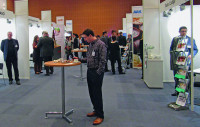Around 300 participants learned lots of new things at Choco-Tec, the three-day chocolate convention that took place recently in Cologne/Germany. The presentations, organized by the ZDS (Central College of the German Confectionery Industry), were complemented by informative exhibits from 39 companies as well as a scientific poster exhibition – each connected with interesting, brief presentations.
By Dr. Bernhard Reichenbach
On the first event day, Choco-Tec explored the topic of global market and product trends. In his presentation, Roman Müggler from Barry Callebaut Sourcing mentioned that the cocoa market is very volatile due to factors including speculative influences, and that stark price fluctuations are typical. For example, cocoa prices fell from 2,500 to 1,400 EUR/t between mid-2016 and early 2018. In past months, it has bounced between approximately 1,500 and 1,700 EUR/t. “This represents a balanced situation between the current strong demand and sufficient supply due to good harvests,” explained Müggler.
Of the around 4.6 m t of cocoa produced in 2017/2018, 76 % came from Africa, 17 % from South America, and only 7 % from Asia. In 2007/2008, of a cocoa harvest totalling around 3.7 m t 16 % came from Asia and only 7 % from South America. One of the reasons: due to significantly increased productivity, Ecuador has become the third-largest producer in recent years, behind the Ivory Coast and Ghana.
Dr Christina Rhosius from Rausch Schokoladen provided information on the latest definitions and developments in chocolate. She made clear that the market was in flux, and that consumers were developing a new consciousness and different desires with regard to their nutrition. Attributes like “healthy,” “organic,” and “high quality” as well as “fair trade” and “transparent production” are becoming increasingly more important. As a result, the market for special cocoa varieties and artisanal chocolate is growing rapidly. Many new (micro)operations were founded, new products were developed, and increasingly more value is placed on certifications. New organizations, institutions, and events like trade fairs were created in order to classify, evaluate, and award distinctions to products – much like in the wine industry.
The second day of the event was devoted to ingredients and their processing. Kay Schumacher from ingredients specialist Bösch Boden Spies underscored the importance of various textures in the taste experience, ranging from creamy and soft to crispy and crunchy. He explained how to create an attractive product presentation and improved taste with dried fruits, nuts, and seeds – which all provide visual, taste, and health benefits. Amongst others, he suggested a solution for the problem that in confectionery the chocolate taste often overwhelms the fruit taste. He recommended reducing the chocolate proportion by adding something like puffed rice, which also makes the use of additional aromas unnecessary.
Julia Cierjacks from the ZDS thematized small-scale chocolate production. Together with increasing global awareness of quality and sustainability, the bean to bar market is also growing constantly. There are currently 215 companies around the world that are active in this sector, 91 of which are located in Europe and 86 in the Americas – with an upward trend. They require efficient production systems for small batches, yet the number of manufacturers is relatively small. Besides various small individual machines to process cocoa beans, Julia Cierjacks also highlighted complete all-in-one solutions. Of particular interest was an innovative solution from manufacturer Tecno 3 for bean to bar production in smaller chocolate volumes, which makes do with just two machines: the Multiprocess R and the Multiprocess C.
About this compact solution, Geert De Smeyter also provided information at the Tecno 3 company’s exhibit booth and at a brief presentation in the Speaker’s Corner. The mobile mini-line Multiprocess R with models up to 30 kg per batch is designed for the speedy production (under one hour) of small quantities of cocoa nibs as well as to process hazelnuts, almonds, etc. It completes the first phase of the bean to bar process by drying, roasting, sterilising, and milling cocoa beans as well as filtering and separating the skins from the nibs. The Multiprocess C with models up to 50 kg per batch transforms cocoa nibs to liquid chocolate within two hours. Then, the nibs are ground, transformed into cocoa mass, and mixed with other ingredients. The paste is subsequently rolled and conched.
The third day of events dealt with the future of chocolate. The array of topics ranged from chocolate printing to customized mass production and the “smart” chocolate factory. Manuel Bruck from Mitaneo reported on the “custom mass production of chocolate bars.” Its most important instrument is the configurator, which allows the customer to create a product exactly to their own specifications regarding shape, contents, and packaging – such as an “individual” product for each family member. “Theoreti-cally, an unlimited number of combinations is possible,” explained Bruck. “The product is not made ahead of time and then stored, but rather produced directly when ordered. This does away with warehousing and capital investment costs for finished or half-finished products.” There are no longer losses resulting from price discounts on excess products, and typical fixed cost blocks are reduced. The relationship between producer and customer becomes closer. More information from the customer’s side leads to continuously improved products, and satisfied customers become advertising ambassadors.
In his presentation on the “Smart Chocolate Factory” and the “Industrial Internet of Things,” Manuel Höhener from Bühler postulated that customized mass production requires a “smart” factory. The meaningful evaluation of gathered and available information in a database increases transparency along the value chain and allows for production that features better control, can react faster, and is more agile. “Data-based self-optimization of the entire integrated value chain is possible,” says Manuel Höhener. This allows problems to be identified quickly, to reduce waste, to save energy and resources, and ultimately to increase efficiency and profitability. According to Manuel Höhener, it is important not to digitalize the old, but to forge new paths.





